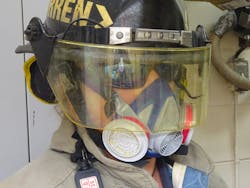University of Extrication: Identifying Carbon Fiber in Vehicles—Part 3
Subject: Carbon Fiber
Topic: Carbon Fiber Structural Materials
Objective: Rescue & Fire Suppression Considerations for Carbon Fiber
Task: Given the potential for a crash with entrapment or a fire involving a vehicle with carbon fiber materials comprising portions of its structure, the rescue team shall develop vehicle rescue and fire suppression protocols.
This third part of our series on carbon fiber involves some initial research on how our typical vehicle rescue tools will hold up against this vehicle structural material at a crash scene. Although the fire service has only limited experience with carbon fiber in passenger vehicles to date, the good news is that it is doubtful that this material will cause us much difficulty at a crash or vehicle fire scene. Even so, there are some challenges and some precautions to be aware of.
Respiratory protection
With research on this material continuing, experiences reported from Formula 1 race track rescue personnel along with reports from aircraft technicians and engineers familiar with carbon fiber indicate that our biggest challenge will be a respiratory issue. It was highly recommended by every expert interviewed who works with carbon fiber that, at a minimum, N95-type dust mask respiratory protection must be worn by responders working with the carbon fiber material, medical personnel in and around our work area, plus the patient as well.
Testing the cutters
I conducted research with various rescue tools on small samples of carbon fiber materials. Initial results indicate that our power rescue system cutters will be able to shear through the material (e.g., roof pillars, rockers and roof rails) without much difficulty. As the blades close, the material shreds rather than cuts cleanly as metal typically does.
Cut testing conducted with a reciprocating saw using a common 10/14 tpi blade indicates that our reciprocating saws will be able to cut through carbon fiber structural materials with ease. The sawing, however, creates a large volume of airborne fibers, making respiratory protection a must.
An air chisel with a panel cutter bit was also able to easily cut through the carbon fiber; however, the material splintered with significant airborne fibers being produced. The cut area looked more like an explosion had occurred rather than cutting.
A small cutoff saw with an abrasive blade was also effective in cutting carbon fibers, but it too created a large cloud of carbon fiber dust that is hazardous to the respiratory system due to the inhalable fibers in the dust cloud.
Fire situations
In a fire situation, testing conducted by research engineers indicates that carbon fiber can burn with a glowing flame, produce significant off-gassing, melt as it burns and even re-ignite. The research indicates that standard vehicle firefighting tactics with copious amounts of water will be sufficient. The key teaching point is that respiratory protection must be worn, not only during the fire suppression but throughout the entire time that any airborne fibers could be present (during the entire overhaul process, for example). Notify your tow and recovery folks about this respiratory issue when they arrive to pick up a burnt vehicle with carbon fiber materials. You might even want to give the driver a dust mask for their protection while handling the car at the scene and later at their storage facility.
Study up
So as BMW continues the roll out its i3 and i8 automobiles, the first mass-production vehicles having their entire occupant area constructed of reinforced plastic carbon fiber, we as fire and rescue personnel have an opportunity to prepare ourselves for the inevitable crash or fire incidents that will occur in the future.
Begin with visits to your BMW dealership when an i3 or i8 car is on the lot. This preplanning will help enormously to prepare your crews. Responders also have the opportunity now to develop a protocol requiring respiratory protection that can be as simple as a dust mask anytime vehicle rescue activities involve using tools to push, pry, cut or saw through carbon fiber material. With some preplanning now, you and your department can effectively prepare to take this new technology in stride.
Read the rest of the series here:
Part 1: How to recognize and manage it at vehicle crashes
Part 2: Taking a close look at the BMW i3
Working Near Carbon Fiber
- N95-type dust mask respiratory protection recommended
- Multiple forms of cutters work but many create significant airborne particles
- Standard vehicle firefighting tactics with copious amounts of water will be sufficient
About the Author
Ron Moore
RON MOORE, who is a Firehouse contributing editor, recently retired as a division chief with the McKinney, TX, Fire Department and now serves with Prosper, TX, Fire Rescue. He self-published the Vehicle Rescue 1-2-3 training manual and serves as the forum moderator for the extrication section of Firehouse.com . Moore can be contacted directly at [email protected].

